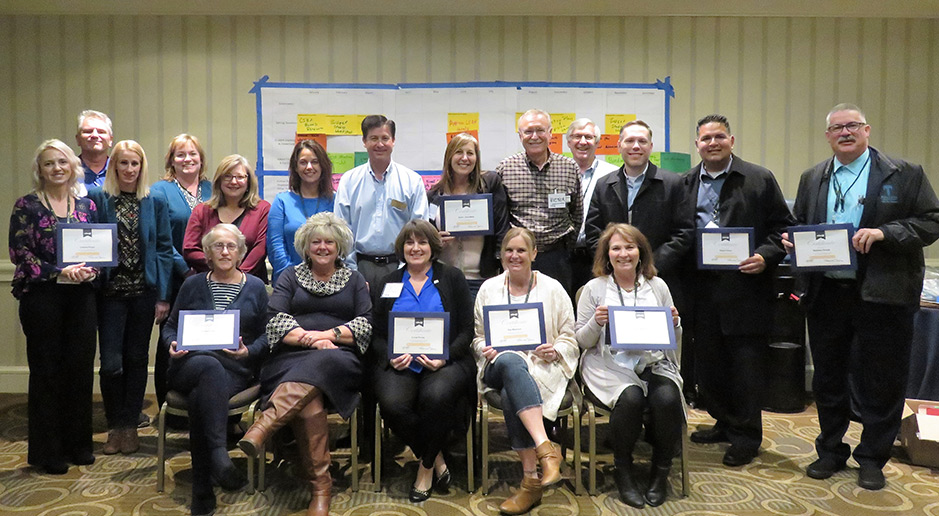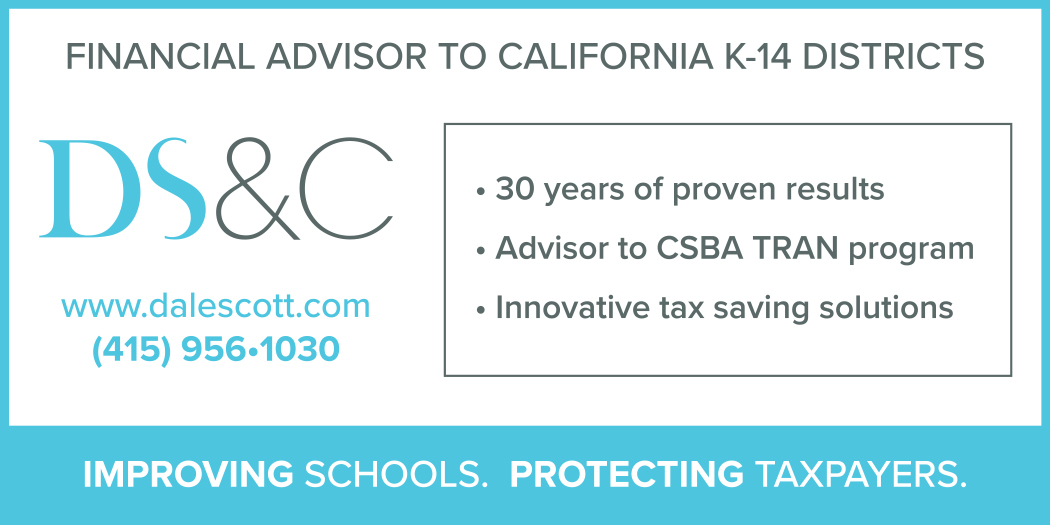

SCA 22 would amend the California Constitution to allow school district parcel taxes to pass with the approval of 55 percent of local voters, rather than the current two-thirds requirement. Among other provisions, parcel tax propositions would have to include a list of programs and purposes to be funded and a requirement that funds be spent solely for those programs, as well as a requirement for an annual independent audit of the tax proceeds collected and expended. The governing board placing the measure would also be required to create a citizens’ oversight board to review all expenditures of proceeds and financial audits, and report its findings to the governing board and the public.
- Visit www.csba.org/Newsroom for links to digital versions of current and past issues of California School News.

The May Revision aligns with the Governor’s overall cautious approach and, consistent with recent budgets, generally shies away from adding ongoing spending. But the revised budget makes little progress toward the full and fair funding of public schools at a time when California is in the bottom 10 states nationally in per-pupil funding.
“The increase in the Proposition 98 guarantee is certainly welcome and will come as a relief to school districts and county offices of education as they grapple with rising transportation, utility, and health and welfare costs,” said CSBA President Mike Walsh. “Simply funding LCFF to targets set five years ago, however, is nowhere close to the full and fair funding needed to provide all California students with an education that prepares them for college, career and civic life.”

Senior Director of Communications:
Troy Flint | tflint@csba.org
Managing Editor:
Kimberly Sellery | ksellery@csba.org
Marketing Director:
Serina Pruitt | spruitt@csba.org
Staff Writers and Contributors:
Hugh Biggar | hbiggar@csba.org
Aaron Davis | adavis@csba.org
Graphic Design Manager:
Kerry Macklin | kmacklin@csba.org
Senior Graphic Designer:
Carmen Rodriguez | crodriguez@csba.org
Mike Walsh | Butte COE
President-elect:
Emma Turner | La Mesa-Spring Valley SD
Vice President:
Xilonin Cruz-Gonzalez | Azusa USD
Immediate Past President:
Susan Henry | Huntington Beach Union HSD
CEO & Executive Director:
Vernon M. Billy
News and feature items submitted for publication are edited for style and space as necessary.


From the iconic companies of Silicon Valley to San Diego’s biotech firms, from Greater LA’s aerospace and entertainment industries to agricultural applications in the Central Valley, science and technology are the economic engines driving California’ economy. If we want to keep it that way — and maintain our global leadership — we must prioritize thoughtful approaches to STEM education that increase both student learning and equity.
CSBA’s continued leadership on STEM education will be on full display at next month’s Leadership Institute, scheduled for July 13 and 14 in San Francisco. This year’s event, titled The Science of Leading Students to STEM Success, will provide a wealth of tools, information and resources related to student achievement. The presentations and workshops will provide crucial insights on policies and practices that governing teams can use to support STEM learning and promote equity, access and excellence.
As executive director of Latina Girls Code, Stephanie Castillo works to bridge and eliminate the diversity gap for girls, specifically Latinas, interested in entering the tech world. California School News asked Castillo to share her perspective on the importance of opportunity and access to the tech fields for all students ahead of her appearance at CSBA’s Leadership Institute, July 13–14.
governance

- CSBA’s legislative agenda supports CTE and mental health funding
- Delegates discuss marijuana legislation and school safety
March 2018 Masters in Governance Graduates
CSBA is proud to recognize our Masters in Governance graduates! and salute their exceptional commitment to professional development in the service of students. MIG completion signifies mastery of the roles and responsibilities of school boards. MIG completion signifies a strong understanding of the knowledge and skills needed to build and support an effective governance structure that helps produce better outcomes for students. Since its inception in 1998, more than 3,000 board members and superintendents have participated in the highly acclaimed certification program.

Cristina Puraci, Redlands USD
Doug Paulson, Board President, Escondido Union SD
Karalee Hargrove, Board President, Morongo USD
Anne Staffieri, Superintendent, Ramona USD
Leigh Chavez, Board Member, Arcadia USD
Aletta Godden, Board Member, Cambrian SD
David Haubert, MIG Faculty
Karen Clark-Mejia, Board Member, Cajon Valley Union SD
Victor Graham, Board Member, San Marcos USD
Bob Caine, MIG Faculty
La Mesa-Spring Valley SD
Robert Perez, Board President, Moorpark USD
Matthew Slowik, Delegate, Region 16B, Fontana USD
Seated, L-R
Denise Cohen, Board Member, Morongo USD
Debbie Moon, Board Member, Romoland ESD
Linda Porras, Board Member, Desert Sands USD
Sue Maulucci, Board President, Covina-Valley USD
Robin Merkley, Board Member, Glendora USD
Eva Marie Martinez, Board Member, Salinas USD
(not pictured)
In one Northern California school district, the expectation is that every board member will have read the entire LCAP before it is presented to the board as a discussion item. In preparation for that meeting, board members are encouraged to:
- Send questions in advance to the superintendent if there is something they don’t see. The superintendent can then respond to the board as a whole with factual information regarding a district issue, without identifying the board member who made the request. Board members need to avoid Brown Act violations by not communicating comments or positions of any individual trustee. Alternatively, if the question requires more discussion, and input from staff and board alike, it may be identified as a topic for a board study session.
- Recast important questions for the benefit of the community, staff and fellow board members during the meeting. By giving staff a heads up that your question will be asked, you are ensuring that the topic will be fully addressed in public.
- Praise good work from the dais. Point out staff efforts that clearly demonstrate progress toward LCAP goals.

Resource allocation and alignment: Were the budget revisions made at the mid-cycle review sufficient in the implementation of programs and achieving LCAP goals?
Community input: What strategies have been employed to reach students and families who are impacted by the services and programs? How has that input from stakeholders informed implementation plans around district goals?
Thinking through these guiding questions with an expressed intent of better serving the needs of the students in your district will ultimately help in creating thoughtful, board-level questions to guide LCAP planning that are relevant and aligned in your local context.
state board
Computer science-related occupations are the number one source of all new wages in the United States, according to Code.org, a nonprofit dedicated to expanding access to computer science in schools and increasing participation by women and underrepresented minorities.
California currently has 74,303 open computing jobs, and had only 4,029 computer science graduates in 2015. Even more concerning, in the 2016–17 school year, only 580 schools in California offered an AP Computer Science course.
Perhaps anticipating this growing need, Assembly Bill 1539, passed in 2014, directed the California Department of Education, Instructional Quality Commission and State Board of Education to develop computer science standards for the state. The recently completed Draft Computer Science Standards are now available for public review and comment through June 20, 2018, on the CDE website at https://bit.ly/2cGC57V. Public comment will also be welcomed at the September SBE meeting.
“By at least one measure — rising high school graduation rates — educational attainment in the United States is the highest it has ever been,” the researchers said. “Without subsequent increases in college graduation, youth employment and civic participation rates, however, questions persist around the quality of education that the high school diploma represents.”
To reach their conclusions, the researchers reviewed coursework requirements for a basic, non-advanced high school diploma for each state. They also assessed whether those courses met requirements for admission to the state’s public university system and career-readiness benchmarks.
With chronic absenteeism a key priority of the Local Control and Accountability Plan and an accountability indicator on the California School Dashboard, districts and county offices of education statewide are making a push to bring down these numbers. The reasons for students missing school vary, but the costs — academic and monetary, due to the loss of average daily attendance funds — can quickly accumulate.
UpcomingEvents info: 800-266-3382
Leadership Institute
MIG Courses 1 & 2
MIG Courses 1-5
MIG Courses 3 & 4
MIG Courses 1-5






